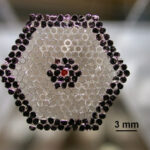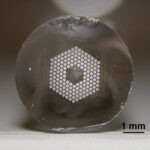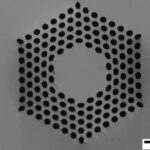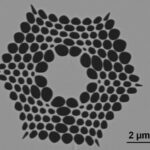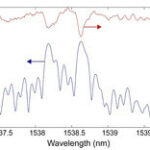- Home
- Research
- Fiber Research and Technology
- Research results
- Far Above the Norm – Development of Anomalous Photonic Crystal Fibers
Far Above the Norm – Development of Anomalous Photonic Crystal Fibers
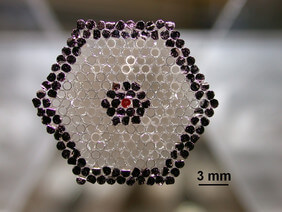
28.03.2019
New fiber designs allow future-oriented applications in fiber lasers – from fiber optic sensors to lab-in-fiber concepts. The point-by-point femtosecond laser writing of fiber Bragg gratings into the core region of a novel photonic crystal fiber was demonstrated for the first time.
Von J. Bierlich // K. Wondraczek // A. Lorenz
Microstructured optical fibers possess a multitude of unique optical properties and thus great future potential in the field of laser and amplifier applications, as well as for sensors and analytics in biomedical and environmental technology. Our optical fiber technology work group specifically covers all research and development activities within the complete technology chain for production of special optical fibers based on quartz glass and soft oxidic glasses. Research activities focus on both material and technology aspects for the implementation of specific structural and doping properties of customized optical preform materials, preforms, and fibers made of these preforms for special applications.
The development of customized microstructured fibers starts with the basic idea of a specific fiber design based on numerical simulations. In a further step, the target design is scaled into a feasible fiber preform structure. Technological implementation of the mostly complex fiber structures includes numerous successive steps – from the preparation of an initial macrostructured preform and its consolidation into a fixed cane structure to the final drawing process to the microstructured fiber.
The preparation of a macrostructured glass preform especially requires the production of a large number of different individual elements (both solid rods and capillaries of different diameters; up to more than 200 pieces per preform), their assembly, cleaning, and geometric arrangement in the jacket tube to form a mostly hexagonal packing structure according to fiber design requirements. In the subsequent cane drawing step, the loose element arrangement of the preform is transferred into a dense, compact secondary preform (i.e., the cane). The aim of this step is the fusion of the rods by dissolving the inter-elemental spaces while maintaining the capillary cavities and generally very good structural integrity.
Depending on the set pressure conditions during cane pulling, the glass capillaries in the preform can be fused together selectively or completely. The possible structure variations have a direct effect on the optical properties of the final fiber structure. The choice of pressure range is an efficient instrument for application-oriented fiber modification. When drawing the cane preform to the final fiber, further degrees of freedom for fiber structure adjustment are again provided by the choice of pressure conditions. The possible variations are either the utilization of the intrinsic capillary pressure in the “passive” pressure control during the drawing process or the application of a defined overpressure in the “active” fiber drawing variation. This makes it possible to strongly influence the inflation and stretching behavior of the capillary cavities (and rings), which allows wide geometric variations in the resulting photonic crystal fiber structure.
As part of the European research project COST MP1401 – AFLASER, it was possible for the first time to inscribe fiber Bragg gratings in optical glass fibers developed in house with a novel photonic crystal structure. [REF] This development was aimed at optical fibers with geometrically defined hollow ring arrangements in µm dimensions and cavity-forming grating structures in nm dimensions. In this novel fiber design, the holey structure periodically arranged around a central glass core is transparent to transversely polarized light. This allows fs laser pulses to be used to inscribe refractive index modifications in the form of so-called Bragg gratings into the core area of the fiber structure using the point-by-point method. With conventional fiber designs, it is usually not possible at all, or only to a very small extent, to write a grid into the core area of the photonic crystal fibers because the transversally incident, exposing laser pulses are defocused due to the unfavorable microstructure. By the targeted adaptation of the periodically structured cladding area, anomalous transparency areas are created which can be optimally used for grid inscription. Point-by-point grating inscription enables the extension of the application wavelength into new spectral ranges. Direct point-by-point inscription of Bragg gratings also allows complex grating structures such as chirped gratings, phase-shifted gratings, and gratings with a superstructure. The new anomalous fiber designs allow, among other things, the development of new fields of application in fiber lasers – from fiber optic sensors to lab-in-fiber concepts.
Funded by: BMBF, H2020, COST

